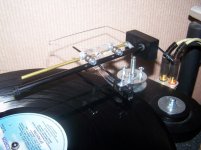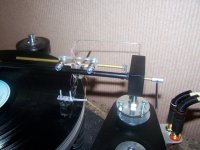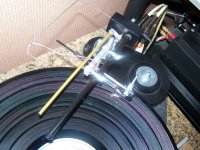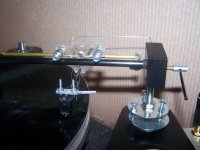Hi Everyone
Once I've figured out how to post some photos, I will do. In the meantime, here are some of my observations/experiences:
I too have been experimenting with a smaller diameter tube. Currently 7mm and hopefully this week 5mm diameter-the current one is much more successful than the 10mm-and the carriage is more stable on this. I'm still having some problems with 'sticking' but I now put this down to the bearings needing a good clean out. That's tomorrow night's job! HOWEVER- when it is working I can testify this is one of the best arms that I have heard-and that goes for the likes of the Ittock, Morch, Notts. Analogue- and the Clearaudio Tangent (had this a couple of years ago). The cartridge (an old VMS 20E with Stilton stylus- whilst I'm experimenting, I'm not going to try anything expensive) - sounds incredible on this arm-very natural and detailed with great separation.
I urge anyone with a modicum of DIY expertise to build this-I can guarantee-you'll be knocked out by it!
I'm going to persevere with this, as I know this is an excellent design. I like the idea of the tungsten rod but don't seem to be able to locate a supplier in the UK. Any ideas anyone?
I'll try and get some help from my daughter later to get some photos on-wish me luck!
Chris
Once I've figured out how to post some photos, I will do. In the meantime, here are some of my observations/experiences:
I too have been experimenting with a smaller diameter tube. Currently 7mm and hopefully this week 5mm diameter-the current one is much more successful than the 10mm-and the carriage is more stable on this. I'm still having some problems with 'sticking' but I now put this down to the bearings needing a good clean out. That's tomorrow night's job! HOWEVER- when it is working I can testify this is one of the best arms that I have heard-and that goes for the likes of the Ittock, Morch, Notts. Analogue- and the Clearaudio Tangent (had this a couple of years ago). The cartridge (an old VMS 20E with Stilton stylus- whilst I'm experimenting, I'm not going to try anything expensive) - sounds incredible on this arm-very natural and detailed with great separation.
I urge anyone with a modicum of DIY expertise to build this-I can guarantee-you'll be knocked out by it!
I'm going to persevere with this, as I know this is an excellent design. I like the idea of the tungsten rod but don't seem to be able to locate a supplier in the UK. Any ideas anyone?
I'll try and get some help from my daughter later to get some photos on-wish me luck!
Chris
DIY Linear Tracker
Hi Everyone
Not sure if I've been successful in uploading photos, but here goes...... It worked. note the leveling apparatus at the base. Simple and works a treat.
Chris
Hi Everyone
Not sure if I've been successful in uploading photos, but here goes...... It worked. note the leveling apparatus at the base. Simple and works a treat.
Chris
Attachments
I like the idea of the tungsten rod but don't seem to be able to locate a supplier in the UK. Any ideas anyone?
Chris
Hopefully hottattoo knows what they are used for, which will give you a starting point for searching.
I've racked my brains about what a precision ground tungsten rod might be used for and the best I can come up with is some kind of large EDM unit, maybe in the aerospace industry.
Hi Chris, I'm very interested in the smaller diameter track tube experiments. I am currently using 10 mm and extremely pleased with the results. One thing that I'd like to get a handle on is what you fellows reporting better "stability" mean by stability. In what way would you say a carriage riding on 10mm tube is less stable than one riding on 7mm or 5mm? Colin spaces his bearings 5mm apart for the 10mm tube. What spacing are you using on the 7mm tube?Hi Everyone
Once I've figured out how to post some photos, I will do. In the meantime, here are some of my observations/experiences:
I too have been experimenting with a smaller diameter tube. Currently 7mm and hopefully this week 5mm diameter-the current one is much more successful than the 10mm-and the carriage is more stable on this. I'm still having some problems with 'sticking' but I now put this down to the bearings needing a good clean out. That's tomorrow night's job! HOWEVER- when it is working I can testify this is one of the best arms that I have heard-and that goes for the likes of the Ittock, Morch, Notts. Analogue- and the Clearaudio Tangent (had this a couple of years ago). The cartridge (an old VMS 20E with Stilton stylus- whilst I'm experimenting, I'm not going to try anything expensive) - sounds incredible on this arm-very natural and detailed with great separation.
I urge anyone with a modicum of DIY expertise to build this-I can guarantee-you'll be knocked out by it!
I'm going to persevere with this, as I know this is an excellent design. I like the idea of the tungsten rod but don't seem to be able to locate a supplier in the UK. Any ideas anyone?
I'll try and get some help from my daughter later to get some photos on-wish me luck!
Chris
If by stability you mean that the carriage is less prone to flip off the track when bumped and your spacing between bearings places the contact points further down on the circumference of the tube, I would expect to see somewhat greater resistance to upsetting the wagon. If this is what is happening, can't we achieve the same goal by spacing the bearings further apart than 5mm when riding on 10mm tube?
At this point in the development it looks to me that we are heading toward the design where the track is a tensioned wire with 2 grooved bearings riding on it. IMHO we are heading away from the goals achieved by Bo in the Cantus.
BillG
Bill,
No worries, I've abandoned the smaller tube, 10mm is bang on on all aspects, the smaller tubes were just steps backwards but worth a try as in this hobby it's a process of ruling things out as much to solidify ruling them in to begin with. The arm stands as is as best, and that brass shim makes a real difference vs secured bearings that are locked at their inner axis.
Colin
No worries, I've abandoned the smaller tube, 10mm is bang on on all aspects, the smaller tubes were just steps backwards but worth a try as in this hobby it's a process of ruling things out as much to solidify ruling them in to begin with. The arm stands as is as best, and that brass shim makes a real difference vs secured bearings that are locked at their inner axis.
Colin
Hi,
ChrisG136:
Tungsten carbide is used for making all kinds of cutting tools like milling cutters, router bits,concrete drill bits etc. It is so hard that you need diamond tooling to machine or grind it. You could try UK ebay under " carbide blanks " .It may actually be cheaper to search US ebay and have it shipped to you if possible. You can search " tool makers " in the UK.
Joe
ChrisG136:
Tungsten carbide is used for making all kinds of cutting tools like milling cutters, router bits,concrete drill bits etc. It is so hard that you need diamond tooling to machine or grind it. You could try UK ebay under " carbide blanks " .It may actually be cheaper to search US ebay and have it shipped to you if possible. You can search " tool makers " in the UK.
Joe
Colin, Great!Bill,
No worries, I've abandoned the smaller tube, 10mm is bang on on all aspects, the smaller tubes were just steps backwards but worth a try as in this hobby it's a process of ruling things out as much to solidify ruling them in to begin with. The arm stands as is as best, and that brass shim makes a real difference vs secured bearings that are locked at their inner axis.
Colin
As I may have mentioned a while back, my arm doesn't use any of your design features save two, 4 bearings and loose fit on the axles. My solid axles are aluminum. Their diameter is turned to provide the same loose fit that you have with the brass shim. There is a boss at the inner end which locates the inside bearing. The outside bearing is located by a friction fit brass ring which on assembly is pressed onto the axle far enough to space the bearings 5mm apart. My bearings are free to slide together on the axle but the diameter of the glass tube and gravity keeps them 5mm apart. Yes I think that the loose fit of the bearing on the axle is a key to the performance of the arm. In a sense it makes a self aligning bearing of sorts. If there is any small runout in the rotating assembly due to eccentricity of either bearings or tube, the clearance between bearing and axle will tend to compensate and permit unconstrained rotation. This explanation is pretty much off the top of my head and may not be sustained by rigorous analysis.
On another subject now, cartridges. I've had a couple of ADC XLM 2 (or3) carts hanging around in my junk box for years. I inherited them. Out of curiosity I just bought one of the low priced RXL/RZD styli advertised by Amazon. Diamond eliptical. Placed it in service a couple of nights ago. On this arm it easily equals or exceeds the Ortofon OM with OM10 stylus. A very nice cartridge. It tracks well at 1 gram Thanks to the surface of the glass and the polished corners on the bearings. Saw some bearings at a hobby shop over the weekend. Didn't have a loupe with me but feeling the corners with my finger nail said that they could be better than the ones I had to polish.
Rgds,
BillG
Last edited:
Siddley:
Sorry, I should have been more clear. Tungsten carbide is much harder, you can get lengths to 1 foot long here without much trouble. If you do order a piece make sure it is ground and polished and have them cut it to your exact length. If you want to go a step further you can get some super fine diamond lapping compound on ebay ( pretty cheap ) and spin the rod in a lathe and get a mirror finish.
A quick check on ebay (USA) under " carbide blank " shows a 7/16" diameter x 12" long piece for $79 which would be just about perfect.
Someone here who wants to make an " ultimate " attempt at this arm should scoff this up quickly. I already have a piece of 1/2" x 12".
ChrisG139:
Nice arm you made. But do not form any opinions about the arms performance until you ditch the fiberglass tube. If you want something quick and much better ( and cheap )get yourself a piece of " drill rod " which you can get from most tool supply houses. Even this is not ideal because it is not hardened. When you are happy with the performance go for the tungsten carbide rod--- you will be a very happy camper !!
Joe
Sorry, I should have been more clear. Tungsten carbide is much harder, you can get lengths to 1 foot long here without much trouble. If you do order a piece make sure it is ground and polished and have them cut it to your exact length. If you want to go a step further you can get some super fine diamond lapping compound on ebay ( pretty cheap ) and spin the rod in a lathe and get a mirror finish.
A quick check on ebay (USA) under " carbide blank " shows a 7/16" diameter x 12" long piece for $79 which would be just about perfect.
Someone here who wants to make an " ultimate " attempt at this arm should scoff this up quickly. I already have a piece of 1/2" x 12".
ChrisG139:
Nice arm you made. But do not form any opinions about the arms performance until you ditch the fiberglass tube. If you want something quick and much better ( and cheap )get yourself a piece of " drill rod " which you can get from most tool supply houses. Even this is not ideal because it is not hardened. When you are happy with the performance go for the tungsten carbide rod--- you will be a very happy camper !!
Joe
Bill,
To me thats part of the beauty of this design, we have a bearing system that works well and needs to be pretty much done a certain way, but each is free to design his or her own carriage ideas and tastes around this and still have success as long as the laws if physics are also adhered to mass wise. I've been trying to out do myself on the bearing arrangement with no luck, it works damn well as it stands and obviously is the important cog in the equation.
For the fiberglass tube being used, it will be enough for now to get started but Pyrex. Or quartz will be ideal and still leave money for more records .
.
Colin
To me thats part of the beauty of this design, we have a bearing system that works well and needs to be pretty much done a certain way, but each is free to design his or her own carriage ideas and tastes around this and still have success as long as the laws if physics are also adhered to mass wise. I've been trying to out do myself on the bearing arrangement with no luck, it works damn well as it stands and obviously is the important cog in the equation.
For the fiberglass tube being used, it will be enough for now to get started but Pyrex. Or quartz will be ideal and still leave money for more records
Colin
Last edited:
If you want something quick and much better ( and cheap )get yourself a piece of " drill rod " which you can get from most tool supply houses. Even this is not ideal because it is not hardened.
Joe
Hey Joe ( sorry, couldn't resist that - I'm a huge fan of Hendrix )
The nearest equivalent to drill rod in the UK is precision ground " silver steel " - even without heat treatment it's pretty hard and I use it a lot for tool making. I really doubt the surface hardness would be an issue in this application.
What is going to matter is that it rusts. Not as badly as some steels, but it will corrode. How fast it corrodes is going to depend on your climate.
Tungsten Carbide- located a UK supplier but they only supply in 4" lengths!
That's the best I could do as well Chris.
You might want to get your hands on a dead printer and strip the chromed steel rods that the printhead rides on out of that - they really are good stuff.
Hi,
Siddley:
One other advantage to using tungsten carbide is that it is only slightly magnetic. This may be an issue with the cartridge only 2 or 3 inches from the carriage support, and of course the corrosion factor of tool steel is a problem.
About 2 years ago I built a magnetic levitation turntable bearing using 2 very strong n50 ring magnets which was used to float a 45 lb aluminum platter ( works very well ). I used a 5/8" diameter mirror finished tungsten carbide shaft 6" long and I was concerned about the magnetic field traveling through the shaft and interfering with the cartridge as it got close to the end of the record. So far no problems. Even when surrounded by 2 105 lb lift magnets the top of the shaft was only slightly magnetic.
Joe
Siddley:
One other advantage to using tungsten carbide is that it is only slightly magnetic. This may be an issue with the cartridge only 2 or 3 inches from the carriage support, and of course the corrosion factor of tool steel is a problem.
About 2 years ago I built a magnetic levitation turntable bearing using 2 very strong n50 ring magnets which was used to float a 45 lb aluminum platter ( works very well ). I used a 5/8" diameter mirror finished tungsten carbide shaft 6" long and I was concerned about the magnetic field traveling through the shaft and interfering with the cartridge as it got close to the end of the record. So far no problems. Even when surrounded by 2 105 lb lift magnets the top of the shaft was only slightly magnetic.
Joe
- Home
- Source & Line
- Analogue Source
- DIY linear tonearm



